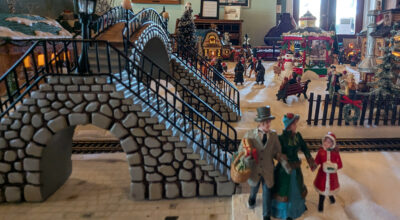Author details Rowan Rifle Guards
Published 12:00 am Monday, July 18, 2011
SALISBURY — Dr. Philip Hatfield, a psychologist and U.S. Army veteran, considers Civil War history his hobby and long ago he became immersed in the men of Company K, also known as the Rowan Rifle Guards.
The “Rowan Rifles” organized in 1857 as sort of a volunteer, minute-man force, which could respond to any crisis.
Truth was, beyond its regular drilling, the Rowan Rifle Guards appeared mostly in parades and musters. Men who were part of the group joined because their friends and relatives did and, it could be said, being part of the Rifles probably helped their social standing and prospects with the women folk.
The Rowan Rifles were “young men from hardworking, yeoman farmer, laboring families,” Hatfield says in his recently published book about Company K. Clerks, apprentices and farmers, mostly. Only a few were wealthy.
The average age of the group was 22, and the majority were from Rowan County, though the ranks also included men from counties such as Cabarrus, Iredell, Davie, Davidson, Gaston and Montgomery.
The volunteer company — and those elsewhere in North Carolina — actually offered a smart, disciplined contrast to the enrolled county and state militia.
You can imagine that the well-equipped Rifles and the Salisbury Brass Band of this same period were a sense of pride for the town in the late 1850s.
But it’s hard to believe that any members of the Rowan Rifles knew what lay ahead of them back in the pre-Civil War days when Salisbury — and North Carolina, for that matter — was not keen on secession, though a crisis was brewing.
How could they have known that as a part of the 4th North Carolina State Troops, they would participate in every major campaign waged by the Army of Northern Virginia and have a handful of men among those surrendering in 1865 at the Appomattox Court House?
“As the remnant of Company K stacked their weapons,” Hatfield writes, “E.A. Osborne overheard the following bittersweet remark from an unidentified member of Company K, who set his gun down at the surrender with a sigh, saying, ‘Sit there, Betsy, you’ve made many of them bite the dust.’”
It’s interesting to read the list from Company K who surrendered because many of the names are still common today in Rowan County: 1st Lt. Marcus Locke Bean, 2nd Sgt. Alfred C. Carter, Cpl. Andrew Mowrey and Pvts. George Basinger, Wilburn C. Frayley, James McCanless, William McQueen, Frances M. Mills, George A. Misenheimer and George D. Snuggs.
Hatfield says Company K had five other men on detached duties at the time and were not on the grounds for the actual laying down of arms. They included Pvts. Lindsey Bryant, J.L. Bogle, James W. Bean, Alexander M. McQueen and Michael Beaver.
Among 115 men present in Company K back in 1861, Hatfield writes, “there was a 6 percent survival rate across the war.” He says the Rowan Rifles’ attrition over the four years came from men killed in action or dead from illness, the wounded and disabled, deserters and those taken as prisoners of the North.
The last surviving members of the Rowan Rifles died in 1930.
Hatfield, who now lives in Fayetteville, spoke last week to the Rowan Rifles No. 405 of the Sons of Confederate Veterans in Salisbury.
A West Virginia native, Hatfield married a Rowan County girl, Rachel Miller, and lived here from 1992-2008. The couple have four children.
Hatfield started his research in 1998, culminating in his self-published book, “The Rowan Rifle Guards, A History of Company K, 4th Regiment North Carolina State Troops, 1857-1865.”
Hatfield says a driving force in his research was an attempt to answer the question, “Who was the Confederate soldier?”
He thinks modern-day analysis of the Civil War often strays too far from “original sources,” documents such as muster rolls and first-person narratives.
Hatfield says he looked for as many “eyewitness testimonies” as he could and found the words soldiers often used about the Civil War were “dramatically different” from what people writing about it 150 years later say.
He trusts the soldiers’ words.
“I believe the historic evidence defies the notion that ‘Johnny Reb’ was always starved and ragged during the war,” Hatfield says in the preface to his book.
Hatfield’s research often centered on finding as much biographical information as he could on the members of the Rowan Rifles and the conflicts they were in as part of the 4th Regiment.
He depended on diaries, letters home, newspaper dispatches, supply orders, Census information and more.
Muster rolls represent, for example, eyewitness details, Hatfield says. The soldiers had to sign the roll themselves and attest to the information, such as how old they were and where they were from.
Over 380 pages, Hatfield provides some new insights into the Rowan Rifles and the campaigns in which they fought — one more contribution to our history, which always seems to be a moving target.
The book is filled with biographical sketches of Confederate soldiers from Rowan and the outlying region who were part of the Rifles.
As information keeps building, Hatfield plans future revisions and updates to his work related to both Company K and the 4th North Carolina State Troops. He sells his book for $25, and it is available locally at the Rowan Museum and Literary Bookpost. Amazon.com has the book for $30.
Contact Mark Wineka at 704-797-4262, or mwineka@salisburypost.com.


